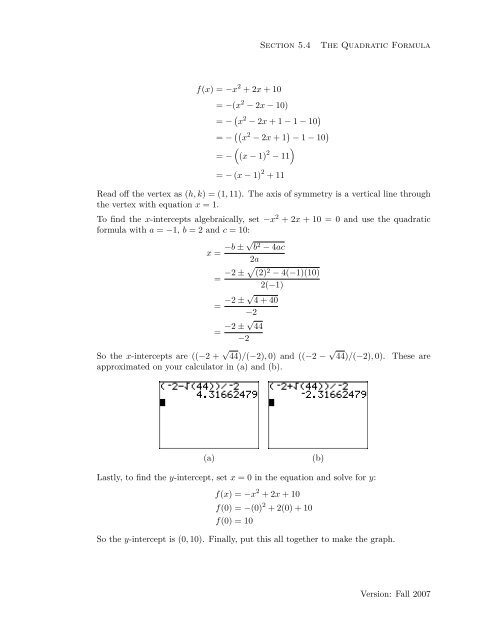Chapter 5: Exercises with Solutions
Chapter 5: Exercises with Solutions
Chapter 5: Exercises with Solutions
- No tags were found...
Create successful ePaper yourself
Turn your PDF publications into a flip-book with our unique Google optimized e-Paper software.
Section 5.4The Quadratic Formulaf(x) = −x 2 + 2x + 10= −(x 2 − 2x − 10)= − ( x 2 − 2x + 1 − 1 − 10 )= − (( x 2 − 2x + 1 ) − 1 − 10 )()= − (x − 1) 2 − 11= − (x − 1) 2 + 11Read off the vertex as (h, k) = (1, 11). The axis of symmetry is a vertical line throughthe vertex <strong>with</strong> equation x = 1.To find the x-intercepts algebraically, set −x 2 + 2x + 10 = 0 and use the quadraticformula <strong>with</strong> a = −1, b = 2 and c = 10:x = −b ± √ b 2 − 4ac2a= −2 ± √ (2) 2 − 4(−1)(10)2(−1)= −2 ± √ 4 + 40−2= −2 ± √ 44−2So the x-intercepts are ((−2 + √ 44)/(−2), 0) and ((−2 − √ 44)/(−2), 0).approximated on your calculator in (a) and (b).These are(a)(b)Lastly, to find the y-intercept, set x = 0 in the equation and solve for y:f(x) = −x 2 + 2x + 10f(0) = −(0) 2 + 2(0) + 10f(0) = 10So the y-intercept is (0, 10). Finally, put this all together to make the graph.Version: Fall 2007
















